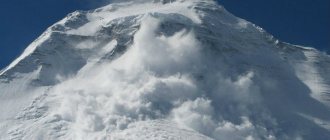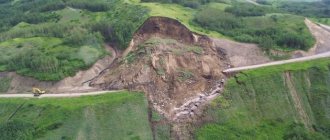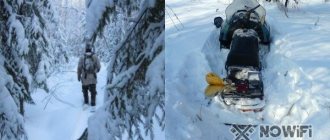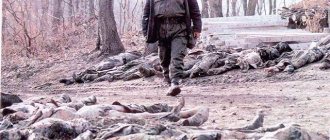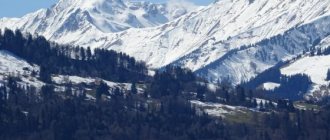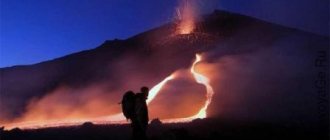What is a snow avalanche?
This is a heavy mass falling or sliding down the slopes of mountains. As a rule, snow melts from slopes with a steepness of more than 30°, but avalanches are also possible on bare slopes with a steepness of 7-20°. But on mountains with a slope of more than 50°, snow does not accumulate; it melts in small batches.
Mountain avalanches are dangerous for people due to their mass, sometimes reaching several hundred tons. In the Krasnoyarsk Territory there are no mountains high enough to allow the snow mass to accelerate to dangerous speeds, but even a small avalanche can kill a person caught in its path. If the victim is buried under the snow mass, he faces death from lack of oxygen and hypothermia.
Properties of snow
It is also important to note the classification associated with the properties of the snow itself, which is the basis of the avalanche. There are dry, wet and wet
The former are characterized by a high speed of convergence and a powerful destructive air wave, and the masses themselves are formed at fairly low temperatures after significant snowfalls. A wet avalanche is snow that has decided to leave the cozy slopes at temperatures above zero. The speed of movement here is lower than in the previous ones, however, the density of the cover is greater. In addition, the base can freeze, turning into a hard and dangerous layer. For wet avalanches, the raw material is viscous, wet snow, and the mass of each cubic meter is about 400-600 kg, and the movement speed is 10-20 m/sec.
Avalanche dangerous places in the Krasnoyarsk Territory
The most famous, probably, avalanche-prone section of the road in the Krasnoyarsk Territory is “Polka” in the Ermakovsky district.
The narrow section of the federal highway used to be regularly covered with snow that fell from the steep mountains. Avalanches often covered cars, and there were even cases of death. Therefore, at the beginning and end of the last century, they decided to build an avalanche gallery in this place. The long-term construction was completed in 2013 and now the length of the avalanche gallery has become a record for similar facilities in Russia - 1340 meters. However, avalanches are still recorded on the federal highway R-257 “Yenisei”, which can partially block the road.
The second section is 26-28 km of the Kuragino-Cheremshanka highway in the Kuraginsky district. This is a narrow road of regional importance, sandwiched in this area between the mountain and the river. There are few cars here, the volume of snow is not very large, the slope is not very high and steep, so any serious problems usually do not arise here. The only thing that threatens motorists is the long wait for the road to be cleared.
Road services in the Krasnoyarsk Territory are doing everything or almost everything to minimize the risk of serious avalanches on the roads. But no one can give a 100% guarantee of safety. So it’s best to put all the necessary things in the car in advance and learn the instructions for action.
How dangerous are avalanches?
The impact force of an avalanche can destroy even strong concrete buildings, twist metal power transmission masts, and throw not only cars off the road. but also trains, turning equipment into piles of scrap metal. A layer of many meters of dense snow forms on the roads.
A system has now been developed to warn people about the danger of avalanches. It includes a system for classifying the risk of avalanches, the levels of which are indicated by flags and posted at ski resorts and resorts.
- Refrain from hiking;
- Avoid dangerous slopes. You cannot cross them or move in a zigzag, as this can “cut” the snow cover, disrupt the adhesion of the snow to the underlying surface and cause an avalanche. It is best to move along the slope straight up, or at least obliquely.
- Do not go to the mountains after heavy snowfalls for 2-3 days;
- It is recommended to stay in a group of more than 3 people;
- When going out into the mountains, it is advisable to take with you an avalanche transceiver, a mobile phone so that rescuers have the opportunity to find a person covered in snow, as well as special avalanche backpacks;
- It is not recommended to step on snow ledges.
What should be in the car:
- A pair of steel carabiners, a tow rope, wires for “lighting”,
- Shovel (any - sapper, special road or regular),
- A tourist gas burner, an alcohol lamp, a primus stove or several long candles,
- Woolen blanket or blanket (one for each passenger),
- Polyethylene 3-5 m long (at least 1.5 m wide),
- Flashlight (preferably special, car),
- In the car first aid kit, additionally put all the medications necessary for each passenger,
- If you have to spend more than 3-4 hours on the road, you need to have a spare canister of fuel with you.
Avalanche at Buibinsky Pass (“Polke”) in 2009. Several cars were buried under the snow, people managed to get out
Photo: archive of the Siberian regional PSO
What to do if the situation gets out of control:
- Usually, road workers learn about avalanches in advance and manage to inform the traffic police about the danger. Traffic police inspectors then immediately try to stop traffic to allow the snow to be removed. Therefore, if you hear a message that a road is closed somewhere ahead on your route due to possible avalanches, do not ignore this warning. Stay until the road opens near a populated area, gas station, or any other place where you can wait in warmth and relative comfort.
- If an avalanche lands on the road in front of you, you should not “break through” the snow. Firstly, you cannot imagine its depth and the extent of the covered area, and secondly, there is a chance that after the first snow charge a second one may roll down. Stop and carefully examine the mountain slopes. If there are snow blows or overhanging canopies above you, turn around and drive to a safe place. In any case, report the danger by calling 112.
- If the snow falls on your car and completely covers it, turn off the engine immediately - exhaust gases will go into the cabin and you will suffocate very quickly. Try to open the door. This will create a larger air pocket, which will give you the opportunity to breathe, and also give you a chance to get out from under the snow. Once you get out, immediately report the incident to emergency services. Warn other drivers about the danger. If there was someone in front of you on the road, help them get out of the buried car.
- If snow blocks you, but the car is not completely buried, take passengers to a safe place. Call for help, and then try to free the car from the snow captivity using a shovel. If you can’t dig yourself out and help won’t arrive soon, get back to the car. Close the doors tightly, insulate the leeward side of the car with spare items or polyethylene to reduce heat loss. Start the car periodically to warm up the interior. At the same time, make sure that snow does not cover the exhaust pipe, otherwise gases will begin to enter the car.
Photo: Anna Kravchenko
Officially:
On the website of the regional administration of the Ministry of Emergency Situations of Russia for the Krasnoyarsk Territory, in the forecast section it is indicated that in the region there is a risk of snow melting in the mountainous regions of the region on sections of ski and mountaineering routes, in the mountains of Western and Eastern Sayan.
But the bulk of those killed in avalanches are people who find themselves within avalanche-prone areas - these are freeriders, snowmobilers, tourists, climbers and other lovers of “off-the-beaten paths.”
There are also cases where snowboarders riding alone off-piste died, covered in snow or fell into “snow cones” - voids formed under the snow next to trees.
Ideally, hikers traveling in avalanche-prone areas should receive avalanche safety training and regularly practice rescuing themselves and others from the snow. Backcountry lovers should take into account the recommendations of experts when planning a route and choosing a descent line in avalanche-prone areas.
Photo: Anna Kravchenko
All about avalanches: interesting facts
- The avalanche speed can reach 100-300 km/h. A powerful air wave instantly turns houses into ruins, crushes rocks, demolishes cable cars, uproots trees and destroys all life around.
- Avalanches can come from any mountain. The main thing is that they are covered with snow. If there have been no avalanches in a certain area for 100 years, then there is always the possibility that they may occur at any time.
- Approximately 40 thousand to 80 thousand people lost their lives during the First World War, they were buried under avalanches in the Alps. Data is approximate.
- In America (California), people surrounded Mount St. Gabriel with deep ditches. Their dimensions are equal to football fields. Avalanches descending from the mountain linger in these ditches and do not roll into populated areas.
- This destructive natural phenomenon is called differently among different peoples. The Austrians use the word "schneelaanen", which means "snow flow", the Italians say "walanga", the French - "avalanche". We call this phenomenon an avalanche.
An avalanche is characterized by the significant destructive power of snow, which approaches, occurs suddenly, moves at a speed of over 10 m/s, and can reach over 15 meters in height. An avalanche is characterized by the rapid, sudden movement of snow and/or ice down steep mountain slopes. The main danger of a snow avalanche manifests itself in the form of a direct impact on people and obstacles (structures, buildings, life support systems). Avalanche hazard factors: significant number of injuries and casualties; collapse with a thin mass and destruction of houses and buildings, potentially dangerous objects, roads, bridges, engineering structures, life support systems; destruction of forests and significant losses to agriculture.
Actions of the population in case of threat, avalanches.
- 1. Listen carefully to the information on TV and radio about the situation, recommendations on the course of action.
- 2. Stay calm, warn your neighbors, provide assistance to the disabled, children and the elderly.
- 3. Remember that you can only escape from an avalanche by avoiding it. If there is time, precautionary evacuation of the population is organized in advance.
- 4. Prepare documents, clothes and collect the most necessary and valuable things, a small supply of food for several days, drinking water, medicines, a flashlight, a battery-powered receiver.
- 5. Turn off the electricity, gas and water supplies, extinguish the fire in the pipes.
- 6. Close windows, doors, ventilation and other openings tightly.
- 7. Remove flammable and toxic substances from the house and, if possible, hide them in pits or cellars.
- 8. Go out on your own to safe places on a hill in case of emergency evacuation (the evacuation route must be known in advance).
- 9. Dear travelers, remember these rules: do not go to the mountains in snowfall or bad weather; study your route before traveling to the mountains; keep an eye on weather changes in the mountains;
- 10. Remember that the most dangerous period for avalanches is spring and summer, from 10 a.m. to sunset;
- 11. Avoid places where avalanches are possible (often it happens when the slope is steeper than 300, if the slope is without bushes and trees - at a steepness of 200; and with a steepness of 450, avalanches happen almost after every snowfall);
Actions of the population in case of snow avalanches.
- 1. Stay calm, avoid panic, and if necessary, provide assistance to disabled people, children, elderly people and neighbors.
- 2. When you hear the sound of an approaching snow avalanche, immediately hide behind a rock or tree, lie on the ground, protect your head with your hands, press your knees to your stomach, orienting your body according to the movement of the avalanche and breathe through your clothes.
- 3. You are caught and carried away by an avalanche: a) perform swimming movements and, if possible, stay from the edge of the avalanche, where the speed of movement is lower;
- b) try to create space around your face and chest in the event of an avalanche stopping - this will help your breathing;
- c) do not scream if you find yourself inside an avalanche, the snow completely absorbs sounds, and screaming and meaningless movements will only deprive you of strength, oxygen and heat;
- d) don’t panic and don’t let yourself fall asleep;
- e) remember that they are looking for you and can save you for some time.
Actions of the population after an avalanche.
What to do if the situation gets out of control:
- At the first suspicion of an emergency situation, you need to go to the nearest shelter as quickly as possible.
- If a mass of snow catches up with you, you need to try to maintain your balance and continue moving and trying to get out of the avalanche zone.
- If the snow drags you along with it, you need to get rid of sticks and any attachments - they will pull you under the snow or lead to injury.
- If you are caught in an avalanche of freshly fallen snow, it is recommended to do swimming movements and anything that can increase your buoyancy and help you stay on the surface. If you see the edge of an avalanche, try to swim towards it.
- If there is a “hard board”, it is recommended, on the contrary, to take a fetal position in order to have a minimum area of contact with the avalanche blocks. In this case, you need to pull your hands up to your chin to create an air pocket near your neck.
- The main tasks while moving in an avalanche: do not lose consciousness; don't suffocate; don't be injured.
- After stopping the avalanche, clear as much space as possible in front of your face. This must be done quickly enough before the snow compacts.
- Stay calm, save energy and wait until they dig you up. Screaming in the snow is useless; you will only lose strength and use up your oxygen supply.
- When you are being dug up, if possible, tell the rescuers information about yourself - how you feel, what hurts, etc.
- If after an avalanche you find yourself on the surface, do not lie down to rest, you do not have time for this - the cold is working against you every second. Report what happened by phone (on the radio) to your comrades and rescuers and try to leave the danger zone on your own.
Experts advise: don’t deliberately create problems for yourself. In an area where there is at least a potential danger of avalanches, behave as carefully as possible, and best of all, refuse the risk. You should not rely on various means and methods of rescue when caught in an avalanche - they only add a chance of survival, but do not guarantee anything.
Cover stability
Trying to answer the question of what an avalanche is, a person realized the need for the ability to assess the stability of snow covers. Predicting such a phenomenon is the most important task of the service to protect the civilian population from disaster. Currently, many methods have been developed for assessing the probability of an avalanche, but not all are considered accurate and reliable. And even the most common methods have disadvantages caused by the unpredictability of weather behavior, the uniqueness of the mountain area’s topography and its extreme heterogeneity.
It is important to understand that the assessment results are generally applicable only to a specific area of the area and may only be relevant for a limited period of time. One of the common means of determining the level of stability is a method that analyzes the results of observations of the speed of movement of snow covers
At certain points in the area, devices are installed that record this indicator. Next, a certain conclusion is drawn. In cases where the speed reaches twelve cm per day, the risk of avalanche formation becomes greater. Security measures should be taken to reduce the level of casualties and destruction to a minimum.
An avalanche can hit anyone in or near the snowy mountains. If the subject is overtaken by such a problem, then first of all it is recommended to get rid of the luggage, and leave, if possible and time, only the most necessary and easy things. It is recommended to try to stay close to the surface and roll over the snow mass. If you get caught in an avalanche, you should make movements like swimming, and very actively. This may help the victim get out
After the avalanche has stopped, you need to create an air bag and, if you are at a shallow depth, pull your hand up, attracting the attention of rescuers. At great depths, it is better to try not to move and save oxygen
Screaming can cause snow to enter the airways or cause another snowfall.
